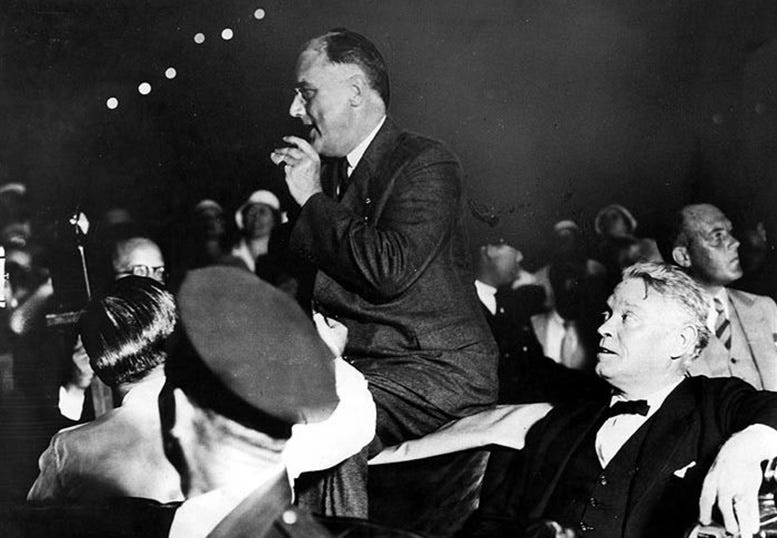Attempted Assassination of FDR in Bayfront Park in 1933
On February 15, 1933, prior to his inauguration as the 32nd President of the United States, Franklin Delano Roosevelt was nearly assassination in Bayfront Park in Miami, Florida. Here is the timeline.
It was February 15, 1933, and there was great anticipation in Miami for the scheduled visit of the president-elect to the Magic City. After the 1932 election and prior to his March 4th, 1933 inauguration, Franklin Delano Roosevelt chose Florida as the place where he would take a vacation. His original plan was to take his private railway car into Jacksonville, board Vincent Astor’s yacht, the Nourmahal, go fishing for several days and then return to Jacksonville to head back up to New York.
However, it was suggested by Robert H. Gore, the publisher of the Fort Lauderdale Daily News, that, on the yacht’s return, Roosevelt attend a rally in Miami, where the president-elect can meet influential party leaders and then leave for New York from there. Roosevelt agreed that this was a good idea.
Franklin Delano Roosevelt Vacation before Inauguration
Although times were very difficult for all Americans in the depths of the Great Depression, there was a spring of hope with the election of Franklin Delano Roosevelt. His vision for economic recovery was seen as the last great hope for capitalism. Miamians knew that this visit of a president-elect was something special. After twelve days of cruising and fishing, the Nourmahal sailed into Biscayne Bay on February 15th as the sun was setting. It was roughly 7pm and as the yacht was being tied up to the municipal docks, the passengers enjoyed a festive farewell dinner.
Shortly after dinner was finished, Roosevelt met with reporters and quickly made it clear that he was not going to discuss cabinet appointments. He discussed his fishing exploits and confirmed that he enjoyed his time away from politics. After the reporters left, Roosevelt met with the Mayor of Miami, Redmond Gautier, to escort FDR to the park. The city had planned a rousing welcome home party complete with all the fanfare of a presidential welcome.
The plan was to usher the president-elect to the area near the amphitheater bandstand in Bayfront Park, where he would give a brief, and as he put it to the press “inconsequential” speech, and then he would be driven to the train station. There he would greet the people that had gathered near his private railway car, and then depart for New York by 10:00pm.
As most Miamians made their way to Bayfront Park, there were roughly 2000 others gathered at the train station anticipating a closer look at the president-elect as he would later board his private rail car in order to depart Miami for New York.
At 9:00pm in the evening, Roosevelt’s party left the yacht and boarded three waiting cars to head to the bandstand. By ten minutes after nine, the cars traveled the one hundred yards to reach Biscayne Boulevard and were joined by several other vehicles occupied by prominent people. The motorcade traveled very slowly to the amphitheater bandstand because of the number of people that lined Biscayne Boulevard.
People had begun to gather in the park by about six in the evening, and by seven o’clock there was standing room only. This was the largest crowd ever to assemble in the history of the city, estimated to be 25,000 people in size. As the motorcade nosed through the crowd, Vincent Astor, riding in the last car, commented on how dangerous of a situation it was for the president given the size of the crowd and the openness of Roosevelt’s green Buick convertible.
A Brief Speech Then Shots are Fired
Roosevelt’s car finally arrived and stopped directly before the steps of the stage to the amphitheater. On stage were a number of dignitaries including the Mayor of Chicago, Anton Cermak. All 7000 seats in front of the stage were filled to capacity, and thousands more filled the aisles and around the seating area.
It was a warm February evening. The trees were filled with red, white and blue lights, and there was a flood light pointing right at the president-elect’s car. The crowd was beyond the brightness of the flood light. Bayfront Park was filled with the sounds of blaring music from the American Legion drum and bugle corps and the sounds of the thousands of people cheering and clapping. Because of his handicap due to polio, Roosevelt was propped up on the back seat of his car. Some of the dignitaries came down from the stage to greet him.
Keep reading with a 7-day free trial
Subscribe to Miami History to keep reading this post and get 7 days of free access to the full post archives.




